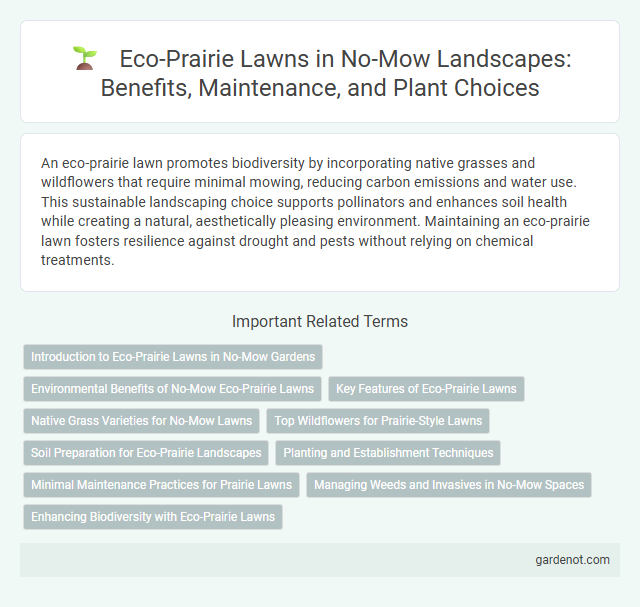An eco-prairie lawn promotes biodiversity by incorporating native grasses and wildflowers that require minimal mowing, reducing carbon emissions and water use. This sustainable landscaping choice supports pollinators and enhances soil health while creating a natural, aesthetically pleasing environment. Maintaining an eco-prairie lawn fosters resilience against drought and pests without relying on chemical treatments.
Introduction to Eco-Prairie Lawns in No-Mow Gardens
Eco-prairie lawns transform traditional no-mow gardens by blending native grasses and wildflowers that thrive with minimal maintenance. These sustainable landscapes enhance biodiversity, support pollinators, and reduce water usage, making them ideal for eco-conscious homeowners. Incorporating species such as little bluestem, purple coneflower, and prairie dropseed creates resilient, low-growing turf that eliminates the need for regular mowing.
Environmental Benefits of No-Mow Eco-Prairie Lawns
No-mow eco-prairie lawns contribute significantly to biodiversity by providing habitat for native pollinators and beneficial insects. These lawns improve soil health through increased organic matter and microbial activity, reducing erosion and enhancing water retention. Reduced mowing decreases carbon emissions and fossil fuel consumption, promoting a more sustainable and environmentally friendly landscape.
Key Features of Eco-Prairie Lawns
Eco-Prairie lawns feature native grasses and wildflowers that enhance biodiversity and require minimal mowing, irrigation, and fertilization. The deep-rooted plants improve soil health, reduce erosion, and support pollinators like bees and butterflies. This sustainable landscaping option lowers maintenance costs while promoting a resilient, drought-tolerant ecosystem.
Native Grass Varieties for No-Mow Lawns
Eco-prairie lawns thrive using native grass varieties such as buffalograss, blue grama, and little bluestem, which require minimal maintenance and no mowing. These drought-tolerant grasses promote biodiversity and improve soil health by supporting local pollinators and beneficial insects. Selecting native species ensures an eco-friendly, resilient lawn that conserves water and reduces the need for fertilizers and pesticides.
Top Wildflowers for Prairie-Style Lawns
Eco-prairie lawns thrive with native wildflowers like Purple Coneflower, Black-eyed Susan, and Butterfly Milkweed, renowned for their drought resistance and pollinator support. These top wildflowers create vibrant, low-maintenance landscapes that reduce mowing needs and enhance biodiversity. Incorporating species such as Little Bluestem grass further promotes soil health and natural habitat in prairie-style settings.
Soil Preparation for Eco-Prairie Landscapes
Effective soil preparation for Eco-Prairie lawns involves deep tilling and the removal of existing grass to promote native plant root establishment. Incorporating organic matter such as compost enhances soil fertility and water retention, essential for drought-tolerant prairie species. Soil pH should be tested and adjusted to a neutral range (6.0-7.0) to optimize nutrient availability for the diverse native plants typical of Eco-Prairie landscapes.
Planting and Establishment Techniques
Eco-prairie lawn planting techniques emphasize selecting native wildflowers and grasses adapted to local soil and climate conditions. Establishment involves preparing the soil through minimal disturbance, using seed mixes with appropriate species ratios to ensure biodiversity and resilience. Proper timing for seeding during early fall or spring promotes strong root development and weed suppression.
Minimal Maintenance Practices for Prairie Lawns
Eco-prairie lawns thrive with minimal maintenance practices such as infrequent mowing, typically once or twice per season, to preserve native wildflowers and grasses. Avoiding chemical fertilizers and pesticides supports biodiversity and soil health, while occasional spot-weeding prevents invasive species without disturbing the ecosystem. These practices reduce water usage and promote a resilient, sustainable landscape that requires less time, effort, and resources compared to traditional lawns.
Managing Weeds and Invasives in No-Mow Spaces
Eco-prairie lawns thrive by maintaining diverse native plant species that naturally outcompete common weeds and invasives in no-mow spaces. Regular monitoring and selective hand-pulling or spot treatments with eco-friendly herbicides help control aggressive invaders without disturbing the ecosystem. Promoting healthy soil and avoiding excessive fertilization discourages weed establishment, ensuring a resilient, low-maintenance landscape.
Enhancing Biodiversity with Eco-Prairie Lawns
Eco-prairie lawns significantly enhance biodiversity by providing diverse habitats for native pollinators, birds, and beneficial insects. Their mix of native grasses and wildflowers supports ecological balance and improves soil health through natural nutrient cycling. This sustainable landscaping approach reduces lawn maintenance, minimizes water usage, and eliminates the need for chemical fertilizers and pesticides.
Eco-prairie lawn Infographic

 gardenot.com
gardenot.com